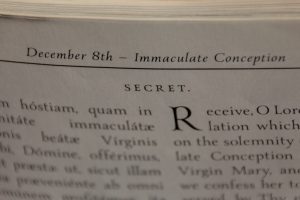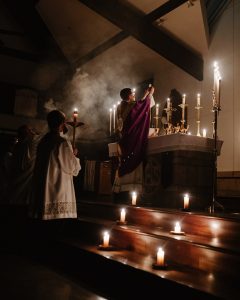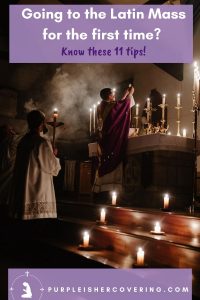Are you going to the Latin Mass for the first time? Read more about what you should know before attending the Tridentine Mass for the first time!
My first trip to the Latin Mass
I am keenly aware of what occurred during my first Latin Mass experience as I attended as an adult for the first time. I had no prior knowledge of the Latin Mass! I was raised Catholic but never went to a Tridentine Mass.
It can be scary the first time! So many questions come to mind like: Isn’t the Latin Mass the long, boring Mass? Don’t I have to know Latin? Does everyone receive communion on the tongue?
I was excited to attend the Latin Mass for the first time. It was special to my, now, husband and I wanted to see why he loved it so much! I had a missal and a chapel veil and was ready to go! Or so I thought. I sure wish I knew what I do now before going for the first time!
My excitement quickly turned to frustration. There are very few verbal prompts loud enough to know where you should be in the Missal. The cues are also in Latin, which I never studied. Further, the priest says all of the parts of the Mass himself even if the choir sings them. I found that listening to the choir would not always match where the priest was in Mass and I got behind in the Missal. I struggled with understanding when to kneel, sit, and stand as it is slightly different from the Novus Ordo.
I continued to attend the traditional Mass on alternating weekends (Novus Ordo on the opposite weekend) until I fell in love with the Latin Mass!
What is the Latin Mass?
The Latin Mass is also known as the Tridentine Mass, the Traditional Latin Mass, the Extraordinary Form, and Usus Antiquior (Latin for “the older use”). The essential elements of the Latin Mass can be recognizably traced back at least 1500 years. The Extraordinary Form is both a valid Mass (in which the sacrifice of Christ’s body and blood truly takes place) and licit (allowed by Church law).
11 tips to know about going to the Latin Mass for the first time
-
Take a friend
If you know someone that already attends the Latin Mass, ask if you can go with them. They can guide you along during the Mass and help guide you as to when to sit, stand, and kneel. A friend can be a source of comfort if you are afraid of going for the first time. If you do not know anyone that already goes to the Latin Mass, try to sit in the middle instead of the front. This way, you can follow the movements of others throughout the Mass.

-
Buy a Missal
Some churches provide a missal or a printout of the propers. However, especially during the pandemic when many churches do not have printed material available, I would recommend buying your own Missal. My husband has the full 1962 Missal and I use the Blessed be God book. The 1962 Missal contains all of the propers in Latin and English. Whereas my little prayer book contains the Collect, Epistle, and Gospel only in English and the ordinary of the Mass in English and Latin. Both books contain the wedding and funeral services and many extra prayers. I prefer the smaller book because I can more easily follow along while wrangling the kids.
Before Mass, make a note of what week it is. Sometimes it is included in the bulletin, handout, or announced before Mass. Accommodating for a misprint or no print (due to the pandemic) and no announcement, I would take the extra step to know ahead of time.
Also, go to the parish’s website and be aware if you are attending a High or a Low Mass. This will slightly change certain things such as when to stand/kneel/sit. The High Mass includes six lit candles on the altar, a deacon and subdeacon, and a choir. Whereas traditionally, the low mass has two lit candles and just the priest. Sometimes you might encounter a “Missa Cantata” which, like a Low Mass, only has a priest without a deacon and subdeacon, but in which the Mass is still sung (missa cantata means “Sung Mass”).

-
Proper Attire
The Latin Mass is not a place to wear jeans, t-shirts, tight-fitting clothing, immodest wear, or “street” clothes. Clothing should be modest, tasteful, and business casual-like. No sneakers or “tennis” shoes should be worn, rather dress shoes should be worn.
Men will be seen wearing full-on suits with ties, dress-up shirts with tie & suit pants, khakis and a button-up shirt with tie, or khakis with a button-up shirt.
Women will be seen wearing tops that cover shoulders (or shawls that cover their shoulders), do not show cleavage, and do not go too far down the chest. Some women recommend only three fingers width below the breastbone should be exposed. Skirts and dresses should go past the knee both while standing and kneeling. Most women choose to wear chapel veils. Some churches even have chapel veils you can borrow for the Mass! I love wearing a chapel veil. I prefer a mantilla veil. It covers my chest and I pull it forward so my peripheral vision is decreased allowing me to focus better.

-
Be present in the Mass
At the Novus Ordo, all you need to do is show up and listen. One can argue you can do the same at the Latin Mass! Some people observe the Mass in silent personal prayer rather than praying along with the Missal. I like to follow along with the Missal. I was confused when I first went, naturally being drawn to what I could hear, the choir, as my guide to follow along. The choir will usually start at the same point as the priest for a section e.g. the introit, but the priest will continue the Mass while the choir sings. Don’t stress about this. Just remember to be present to the sacrifice of the Mass.

-
Be patient with learning
Knowing when to sit/kneel/stand/respond can be tricky at first. This is especially hard while you get used to hearing Latin! Eventually, you will pick up on the Latin words and even start to learn what they mean! Learning when or if the choir sings will become more apparent each time you attend. Soon you will recognize the hymns to sing along if you wish.
I didn’t realize the first time I went that the Epistle and Gospel would be read a second time in English (at some Masses)! Hooray for the parents struggling with the kiddos that they can, at the very least, hear that part repeated. It will become second nature soon enough! Stick with it. I don’t believe if you have never been to a Latin Mass before that you can judge it based on one attendance.
-
Take advantage of the silence
There will be times of silence and peaceful music that you can use to pray, especially after communion. Use that time for daily prayers, prayers for your family/friends, or to do post-communion prayers. My husband and I like the St Thomas Aquinas prayer and the St. Bonadventure prayer:
“O most sweet Lord Jesus Christ, transfix the affections of my inmost soul with that most joyous and healthful wound of Thy love; with true, serene, holiest apostolic charity, that my soul may ever languish and melt with entire love and longing for Thee, that it may desire Thee, and faint for Thy courts, long to be dissolved and to be with Thee.
Grant that my soul may hunger after Thee, the Bread of Angels, the refreshment of holy souls, our daily and supersubstantial Bread, Who hast all sweetness and savor, and the sweetness of every taste.
Let my heart ever hunger after and feed upon Thee, upon Whom the angels desire to look, and my inmost soul be filled with the sweetness of Thy savor.
May it ever thirst for Thee, the fountain of life, the source of wisdom and knowledge, the fountain of eternal light, the torrent of pleasure, the richness of the house of God.
May it ever yearn for Thee, seek Thee, find Thee, stretch towards Thee, attain to Thee, meditate upon Thee, speak of Thee, and do all things to the praise and glory of Thy holy name, with humility and discretion, with love and delight, with readiness and affection, with perseverance even unto the end.
And be Thou ever my hope and my whole confidence; my riches; my delight, my pleasure, and my joy; my rest and tranquility; my peace, my sweetness, and my fragrance; my sweet savor, my food and refreshment; my refuge and my help; my wisdom; my portion; my possession, and my treasure, in Whom my mind and my heart may ever remain fixed and firm, and rooted immovably, henceforth and forevermore. Amen”
There are many prayers that can be said in the Blessed be God book for each part of the Mass to unite your intentions to the Liturgy. I like to use these prayers to stay focused in prayer and not get distracted by the kids and lose that valuable time.
-
Leonine Prayers
At the end of the low Mass, the Leonine prayers are said. If you do not know them, familiarize yourself with them here. These prayers are actually spoken in English; if you have children it’s a great time to get them to participate as well.

-
Health Concerns
One bonus of the Latin Mass, especially during this pandemic, is no sign of peace is exchanged between parishioners. This follows the rubric of the Tridentine Mass and additionally helps to avoid the spread of germs.
Please be prepared for incense at High Masses if you have any respiratory ailments. Fortunately, wearing masks are all the rage now if that helps your condition at all!
-
Ad Orientem
One of the most beautiful parts of the Latin Mass is that the entire church, including the priest, faces the east (ad orientem) the whole Mass. The congregation and priest are lifting up their prayers to God together. The priest offers the sacrifice of the Mass for God; he is not facing you like an audience.

-
Receiving at the altar rail
Kneeling at the altar rail to receive the Eucharist is a great privilege of the Latin Mass. You get to be near the altar with the tabernacle and crucifix close up so you can meditate and say some quick prayers before receiving communion. Practice receiving on the tongue with crackers at home if you have never done this before and feel it will be intimidating. I was worried I would miss and the Eucharist would fall for fear of licking the priest’s hand. Please know that the prayer which priest says when distributing communion includes the Amen; “The Body of our Lord Jesus Christ preserve thy soul unto life everlasting. Amen.” You do not need to subsequently say Amen, you will simply receive on the tongue and return to your pew.
-
You must be in a state of Grace to receive
To receive the Eucharist, please remember that you must have fasted, except for medication and water, for at least one hour before communion. (A lot of people who go to the Latin Mass observe the older custom of fasting for 3 hours or even from midnight, but 1 hour is all that is technically required.) You must reflect on if you have committed any mortal sins between your last confession and Mass. If in doubt–or even if you just don’t feel spiritually prepared–do not receive. It is worse to receive in a state of mortal sin than to be embarrassed about not receiving. You should always have formed a proper intention to reverently receive Our Lord in the Eucharist!

The Last Thing You Need to Know about going to the Latin Mass for the first time is not to be afraid; just give it a try and find a Tridentine Mass near you for this Sunday’s Mass!
I wrote a whole post about the Latin Mass and how it is a great way to deepen your faith through beautiful chants, vivid language, traditional prayers, and peaceful prayer time!
Please feel free to share this post with anyone who might be interested in trying the Latin Mass.
What would you tell a firstcomer before he/she is going the Latin Mass for the first time?


